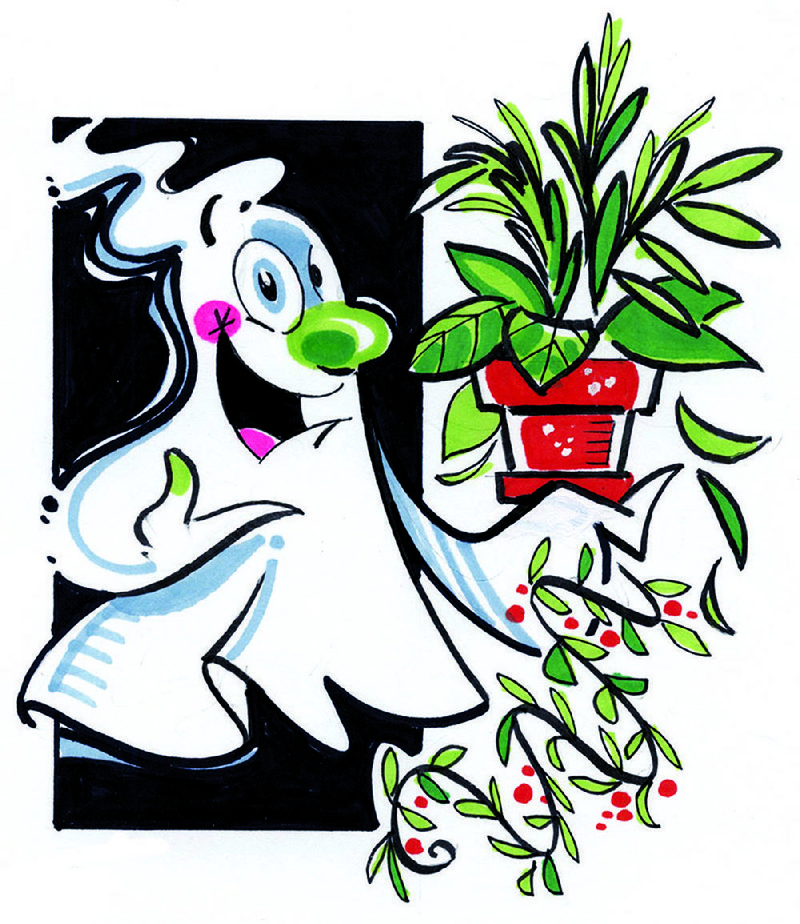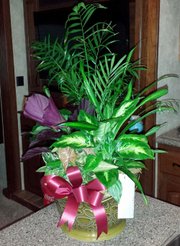Q I received a group arrange-ment of potted plants after a funeral. How do I care for it?
A While not technically a dish garden, this grouping of individual houseplants needs to be separated into individual pots so that each plant has the space it needs to grow. I see at least four types of houseplants in the arrangement -- a palm, a dieffenbachia (dumb cane), a prayer plant and also what looks like a dracaena. They may be individually potted in the arrangement or planted together in one pot, but either way you should give each its own container. Give them bright light and don't overwater, and they should do fine. These combination planters look impressive when you get them, but they are not intended as permanent pots.
Q I am a member of the Tree Board in Maumelle. We have taken on the project of redoing the wildflower garden (approximately 50 feet by 20 feet) in the city park on the shores of Lake Willastein. The garden has few wildflowers and lots of grass, almost waist high in places. We have been getting ideas on how to go about this. Some think we should mow the area as close as possible this fall, spray something to kill everything, spread a very heavy layer of mulch, let the area lie fallow over the fall and winter, and then start with a blank slate in the spring. If we do this, what product would you recommend to spray, and will we indeed be able to plant wildflowers safely next spring? Another option is that we buy heavy black plastic to stake and cover the entire area until next spring, which would kill all the vegetation without using harmful chemicals. This idea would certainly be safer, although possibly more expensive and perhaps too labor intensive. If possible, we would also like to involve the community (boys and girls clubs, Friends of the Park, etc.) and combine a fall Arbor Day project with redoing the wildflower garden by planting small native trees (redbud, etc.?) and shrubs on the edges of the garden. If we spray the area this month, avoiding the areas where the trees will be planted, can we still safely plant them this fall? If so, how much distance should we leave between the sprayed area and the planting sites?
A All are viable options, but if you have well established grass and weeds, I doubt any of them will completely kill out all your grass and weed problems. I would definitely start by getting the area mowed as close as possible. The problem you are going to have is that if the area has been allowed to run amok, even if you mow and kill the existing grass and weeds now or this winter, the area probably has a wealth of weed seeds that will come up next year -- herbicides kill the weeds and grass, not the seeds. I would consider mowing and tilling the area and then covering with plastic. Then next spring, uncover and till again. Let the weeds and grasses germinate and start to grow, then spray with Round-up or another broad herbicide and mulch the area. Consider planting sunflowers or some other annual crop for the growing season to help compete against the weeds; then clean the area of any weeds, grass and the sunflowers and plant wildflowers next fall. Planting trees or shrubs along the perimeter should not be a problem; just don't spray them with any herbicides. Make sure you mulch around them to keep weeds and grass at bay. I know this is a huge project, but taking time to start with a clean, weed-free site will help. The biggest challenge with large wildflower gardens is grass and weeds.
Q We planted a 6-foot redbud tree two years ago. It is well established and growing taller while limbs are getting longer all the way down the trunk. We would like to limb it up so that it is more like a tree than a tall shrub. When is the best time of year to do pruning at the trunk?
A Removing lower limbs can be done at any time of the year. Don't remove more than one third of the growth of the tree. Make clean cuts, and don't use pruning paint or wound dressing. A clean, smooth cut is what is most important.
Janet B. Carson is a horticulture specialist for the University of Arkansas Cooperative Extension Service. Write to her at 2301 S. University Ave., Little Rock, Ark. 72204 or email her at
jcarson@arkansasonline.com
HomeStyle on 09/05/2015

